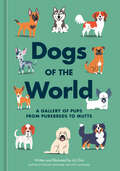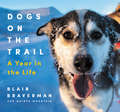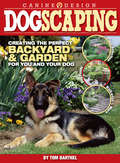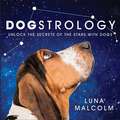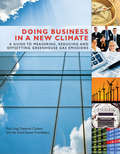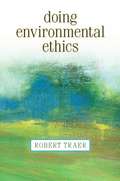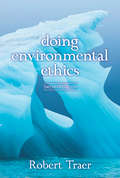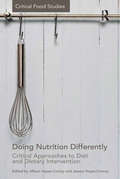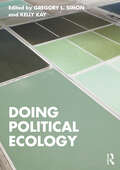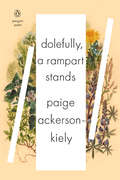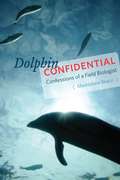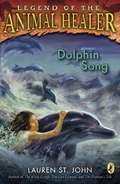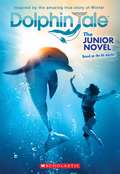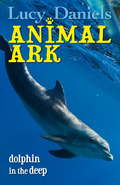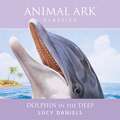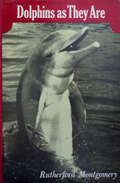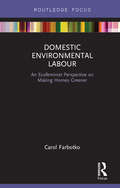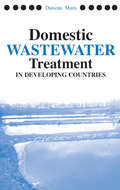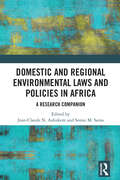- Table View
- List View
Dogs Will Be Dogs: The Ultimate Dog Quote Book
by Erika SargentA gorgeously designed book with words of canine wisdom from dog lovers throughout history—authors, philosophers, humorists, presidents, and more. &“Everyone thinks they have the best dog. And none of them are wrong.&” —W. R. Purche If you&’ve ever owned a dog, lived with a dog, walked a dog, or even pet a dog, you know that they are the four-legged embodiment of happiness. Even when you catch them in the act of chewing your shoes, you can&’t help but love them (and their puppy dog eyes). With quotes from dog-lovers, owners, rescuers, and influencers, Dogs Will Be Dogs is a new kind of quote book about how these furry companions complete our lives. &“Happiness is a warm puppy.&” —Charles M. Schulz &“Children and dogs are as necessary to the welfare of the country as Wall Street and the railroads.&” —Harry S. Truman
Dogs of the World: A Gallery of Pups from Purebreds to Mutts [A Dog Breed Book]
by Lili ChinFrom the noble Afghan to indigenous village dogs, this vibrant illustrated gallery offers fascinating information on more than 600 dog breeds, from the author and illustrator of Doggie Language and Kitty Language.Meet more than 600 types of dogs in this captivating canine gallery, from the English Springer Spaniel and Moroccan Aïdi to the Thai Ridgeback and the New Guinea Singing Dog. Packed with fascinating tidbits and hundreds of illustrations, Dogs of the World also shines a welcome spotlight on the world&’s 85 percent of dogs who are no breed at all, including mutts and village dogs.You&’ll learn about different dog types and their working roles, such as herding, livestock guarding, scent detection, dog sports, and companionship, and understand what terms like purebred and landrace mean. Trace the history of our modern dogs through a vibrantly visual timeline, and pick up insights on breed health risks, personality traits, and how breed ancestry DNA tests work.Featuring adorable artwork and research vetted by dog history experts, behavior professionals, and veterinarians, this is a loving and accessible guide to the diversity of our canine companions.
Dogs on Instagram
by @dogsofinstagramFrom the popular Instagram profile comes this collection of adorable dog photos to warm the hearts of dog lovers everywhere.Dog lovers are a passionate bunch, and Instagram is the perfect platform for expressing their devotion. The curators behind @dogsofinstagram channel this passion perfectly in this delightful book, a must-have collection featuring more than four hundred of the best crowdsourced dog photographs from their wildly popular feed. For dog lovers by dog lovers, this eclectic compilation celebrates the full spectrum of things to love about our four-legged friends.
Dogs on the Trail: A Year in the Life
by Blair Braverman Quince MountainPlease note this is a fixed format ebook. Type size and other formatting features on your eReader are not usable on this file. Your device should allow you to enlarge an individual paragraph by double clicking it. Once you have done so, you may be able to further zoom in and use the “turn page” feature to move to the next paragraph, depending on your device. A delightful photographic journey into a year in the life of a team of sled dogs, based on Braverman’s wildly popular Twitter feedWhen Blair Braverman started posting pictures of her dog team on Twitter, she had no idea the response she would get. Being a musher, after all, isn’t just about racing—raising dogs from puppyhood to retirement (and beyond) is a full-time job. She and her husband, musher Quince Mountain, wanted to share stories about life with their dog team. And not just the big stuff, like expeditions and wild animal encounters, but also the everyday things: the challenge of storing a thousand pounds of raw meat, scouting new trails with the dogs, the decisions that go into putting a team together, how she trains puppies to be brave. These were goofy stories, scary stories, heartfelt stories, stories that clearly connected with people and kept going viral.Inspired by those connections, Dogs on the Trail is a chronicle of a year in the life of their dog team. Beginning in the fall as the weather starts to cool, training on both dry land and in the snow, then camping and racing. Spring brings mud—lousy for sledding, but the dogs love it. And summer is the season of puppies. The book ends on a beginning, in anticipation of the adventurous lives that the new pups have in store.An irresistible adventure, Dogs on the Trail will delight and entertain while taking you inside a musher’s world, and showing you why the wilderness isn’t simply a place to visit but also a home to return to.
Dogscaping
by Thomas BarthelFor dog owners and garden lovers alike, Dogscaping presents a plan for the family dog to live in perfect harmony with a green, beautiful backyard. Whether the family dog is a demon digger like a terrier or a shade-seeking greyhound, Dogscaping offers solutions for all dog owners to create the perfect backyard and garden for all members of the human and canine family. Tom Barthel, a certified master gardener and devoted dog owner, approaches the topic of landscaping for dogs organically-figuratively and literally, whenever possible. Encouraging the reader to pursue organic methods, the author includes a terrific chapter on organic lawns and offers tips for maintaining an earth-friendly (and dog-friendly) green-as-can-be lawn. Between the chapters of this book are profiles called "Organic Gardener: Organic Dog," in which he tells entertaining success stories of dog-owning organic gardeners and hobby farmers. In the chapter "Site Planning and Plant Selection," Barthel advises on how to plan the backyard space taking the dog's habits and proclivities in mind and then makes recommendations for various kinds of vines, groundcovers, shrubs, and urine-resistant plants. In its chapter about maintaining the garden and backyard, Dogscaping presents various organic pest and weed control options, which are safe for the dog and practical for the gardener. The author also offers a list of pest-discouraging plants and methods to deter unwanted weeds and visitors (gophers, deer, squirrels, etc.). In the greenest chapter in the book, "Recycling Home, Garden, and Yard Waste," Barthel makes a compelling case for composting, cataloging both the advantages and savings and offering an easy five-step method of composting. Other additions to the dog-friendly backyard include planting fruits and vegetables, adding a water feature, and incorporating decks, gazebos, pathways, and lighting, all of which are covered in individual chapters in this beautifully photographed book. The final chapter of the book "Creating Doggy Nirvana" provides fun ideas for owners to include dog-specific features into their backyard designs, including a pooch pergola, doggy sandbox, and disappearing fountain. The appendix provides US and North American zone maps. Index included.
Dogstrology: Unlock the Secrets of the Stars with Dogs
by Luna MalcolmA delightfully quirky, cute, and funny guide to horoscopes told through adorable dog photographs. With the help of a collection of sweet and hilarious dog pictures, Dogstrology will unlock all the secrets of the stars that you need to know, including: Each of the signs at their best and worst (and the perfect pup to illustrate them)The common traits of each element and modality in the zodiacWhat do you and your "sister sign" have in common? Find out, with the perfect dog photo to complement it.And of course: the right dog for you, based on your star sign!
Doing Business in a New Climate: A Guide to Measuring, Reducing and Offsetting Greenhouse Gas Emissions
by Morag Carter Paul Lingl Deborah CarlsonAround the world, a growing number of businesses are taking steps to reduce their climate impact by managing their greenhouse gas emissions. At the same time, these businesses are discovering that effective greenhouse gas management can enhance their brands, motivate employees, increase operational efficiencies, and save money. This guide walks readers through the key activities that make up a greenhouse gas management program, including measuring, reducing, and offsetting emissions and developing a communications strategy around the program. Throughout, case studies of over fifty leading businesses from around the world highlight innovation and solutions to common challenges, and further resources are provided for each section. While this guide was developed primarily for the business community, many of the greenhouse gas management practices explored can also be used by other organizations that wish to reduce their climate impact, including government agencies, municipalities, non-governmental organizations and educational institutions. Published with the David Suzuki Foundation.
Doing Environmental Ethics
by Robert TraerDoing Environmental Ethics offers a way to face our ecological crisis that draws on environmental science, economic theory, international law, and religious teachings, as well as philosophical arguments. It engages readers in constructing ethical presumptions based on our duty (to other persons and species and also to ecosystems), our character (personal virtues), our relationships (with other persons and nature), and our rights (to sustainable development and a healthy environment). Then it tests these moral presumptions by predicting the likely consequences of acting on them. Readers apply what they have learned to specific policy issues discussed in the final part of the book: sustainable consumption, environmental policy, clean air and water, agriculture, managing public lands, urban ecology, and climate change. Questions after each chapter and a worksheet aid readers in deciding how to live more responsibly as consumers and as citizens. "What you do matters," Robert Traer writes, "and the person you are also matters. In ethics we look for reasons to explain why this is so.
Doing Environmental Ethics
by Robert TraerDoing Environmental Ethics faces our ecological crisis by drawing on environmental science, economic theory, international law, and religious teachings, as well as philosophical arguments. It engages students in constructing ethical presumptions based on arguments for duty, character, relationships, and rights, and then tests these moral presumptions by predicting the likely consequences of acting on them. Students apply what they learn to policy issues discussed in the final part of the book: sustainable consumption, environmental policy, clean air and water, agriculture, managing public lands, urban ecology, and climate change. Questions after each chapter and a worksheet aid readers in deciding how to live more responsibly. The second edition has been updated to reflect the latest developments in environmental ethics, including sustainable practices of corporations, environmental NGO actions, and rainforest certification programs. This edition also gives greater emphasis to environmental justice, Rawls, and ecofeminism. Revised study questions concern application and analysis, and new "Decisions” inserts invite students to analyze evaluate current environmental issues.
Doing Environmental Ethics
by Robert TraerDoing Environmental Ethics faces our ecological crisis by drawing on environmental science, economic theory, international law, and religious teachings, as well as philosophical arguments. It engages students in constructing ethical presumptions based on arguments for duty, character, relationships, and rights, and then tests these moral presumptions by predicting the likely consequences of acting on them. Students apply what they learn to policy issues discussed in the final part of the book: sustainable consumption, environmental policy, clean air and water, agriculture, managing public lands, urban ecology, and climate change. Questions after each chapter and a worksheet aid readers in deciding how to live more responsibly. The second edition has been updated to reflect the latest developments in environmental ethics, including sustainable practices of corporations, environmental NGO actions, and rainforest certification programs. This edition also gives greater emphasis to environmental justice, Rawls, and ecofeminism. Revised study questions concern application and analysis, and new "Decisions” inserts invite students to analyze evaluate current environmental issues.
Doing Environmental Ethics (Second Edition)
by Robert TraerDoing Environmental Ethics faces our ecological crisis by drawing on environmental science, economic theory, international law, and religious teachings, as well as philosophical arguments. It engages students in constructing ethical presumptions based on arguments for duty, character, relationships, and rights, and then tests these moral presumptions by predicting the likely consequences of acting on them. Students apply what they learn to policy issues discussed in the final part of the book: sustainable consumption, environmental policy, clean air and water, agriculture, managing public lands, urban ecology, and climate change. Questions after each chapter and a worksheet aid readers in deciding how to live more responsibly. The second edition has been updated to reflect the latest developments in environmental ethics, including sustainable practices of corporations, environmental NGO actions, and rainforest certification programs. This edition also gives greater emphasis to environmental justice, Rawls, and ecofeminism. Revised study questions concern application and analysis, and new "Decisions" inserts invite students to analyze current environmental issues.
Doing Nutrition Differently: Critical Approaches to Diet and Dietary Intervention (Critical Food Studies)
by Jessica Hayes-Conroy Allison Hayes-Conroy'Hegemonic nutrition' is produced and proliferated by a wide variety of social institutions such as mainstream nutrition science, clinical nutrition as well as those less classically linked such as life science/agro-food companies, the media, family, education, religion and the law. The collective result is an approach to and practice of nutrition that alleges not only one single, clear-cut and consented-upon set of rules for 'healthy eating,' but also tacit criteria for determining individual fault, usually some combination of lack of education, motivation, and unwillingness to comply. Offering a collection of critical, interdisciplinary replies and responses to the matter of 'hegemonic nutrition' this book presents contributions from a wide variety of perspectives; nutrition professionals and lay people, academics and activists, adults and youth, indigenous, Chicana/o, Latina/o, Environmentalist, Feminist and more. The critical commentary collectively asks for a different, more attentive, and more holistic practice of nutrition. Most importantly, this volume demonstrates how this 'new' nutrition is actually already being performed in small ways across the American continent. In doing so, the volume empowers diverse knowledges, histories, and practices of nutrition that have been marginalized, re-casts the objectives of dietary intervention, and most broadly, attempts to revolutionize the way that nutrition is done.
Doing Political Ecology
by Gregory L. Simon Kelly KaySince its inception, the field of political ecology has served as a critical hub for inclusive and transformative environmental inquiry. Doing Political Ecology offers a distinctive entry point into this ever-growing field and argues that our scholarly “foundations,” today more than ever, comprise a cross-cutting latticework of research approaches and concepts.This volume brings together 28 leading scholars from a range of backgrounds and geographies, with contributions organized into 18 analytical lenses that highlight different approaches to critical environmental research and “ways of seeing” nature-society interactions. The book's contributors engage the breadth and depth of the field, recognizing a variety of roots and genealogies, and give ample voice to these rich and complementary lineages. This inclusive presentation of the field allows diverse theoretical and empirical approaches to intermingle in novel ways. Readers will emerge with a wide-ranging understanding of political ecology and will attain a diverse toolkit for evaluating human–environment interactions.Each chapter astutely grounds key methodological, theoretical, topical, and conceptual approaches that animate a range of influential, cutting-edge, and complementary ways of “doing” political ecology.
Dolefully, A Rampart Stands (Penguin Poets)
by Paige Ackerson-KielyA collection of haunting, image-rich poems about isolation, captivity, and vanishing.The poems in Paige Ackerson-Kiely's third collection are set primarily in the rural northeast of America, and explore rural poverty, entrapment, captivity, violence, and a longing to vanish. Ranging from free verse to a long noir prose poem, they examine who her, or our, "captors" might be. Ackerson-Kiely is interested in characters who are aware of their foibles, and who find ways to turn away from those problems in search of connection and freedom.
Dolphin Confidential: Confessions of a Field Biologist
by Maddalena BearziA &“compelling&” up-close memoir of a career spent among marine mammals and a portrait of the daily lives of dolphins (Publishers Weekly). Working among charismatic and clever dolphins in the wild is a unique thrill—and this book invites us shore-bound dreamers to join Maddalena Bearzi as she travels alongside them. In a fascinating account, she takes us inside the world of a marine scientist and offers a firsthand understanding of marine mammal behavior, as well as the frustrations and delights that make up dolphin research. Bearzi recounts her experiences at sea, tracing her own evolution as a woman and a scientist from her earliest travails to her transformation into an advocate for conservation and dolphin protection. These compelling, in-depth descriptions of her fieldwork also present a captivating look into dolphin social behavior and intelligence. Drawing on her extensive experience with the metropolitan bottlenose dolphins of California in particular, she offers insights into the daily lives of these creatures—as well as the difficulties involved in collecting the data that transforms hunches into hypotheses and eventually scientific facts. The book closes by addressing the critical environmental and conservation problems facing these magnificent, socially complex, highly intelligent, and emotional beings. &“Pairing vivid images of bottlenose dolphins swimming together and caring for one another with descriptions of the meticulous scientific work required to record their behavior, Maddalena Bearzi sheds light on the life of a field biologist…A beautifully written account.&”—Library Journal
Dolphin Song (Legend of the Animal Healer #2)
by Lauren St. JohnMartine is just getting used to her new life on the game reserve with her grandmother and the white giraffe, Jemmy, when she must go away. Her class is going on a trip -- an ocean voyage to watch the sardine run, a spectacular natural phenomenon off the coast of South Africa. <P><P>But the exciting adventure takes a dramatic turn when Martine and several of her classmates are thrown overboard into shark-infested waters! They are saved by a pod of dolphins and end up marooned on a deserted island. Now the castaways must learn to work together, not only to survive but to help the dolphins who are now in peril.
Dolphin Tale
by Gabrielle ReyesAn inspirational true story of friendship between Winter, an injured dolphin with her tail lost in a crab trap and a small boy Sawyer, who goes the extra mile to help Winter fight all odds and swim again with acustom made prosthetic tail.
Dolphin in the Deep (Animal Ark #35)
by Lucy DanielsAnimal Ark is the veterinary surgery run by Mandy Hope's parents. If there are animals to be protected or looked after, Mandy is always there to help.A trip to the States is a dream come true for Mandy! She loves playing with two tame dolphins, Bob and Bing. But when Bob dies, the lonely Bing pines for company. But will Mandy's daring plan to cheer him up work?DOLPHIN IN THE DEEP is one of the best-loved ANIMAL ARK stories. Have you read them all?
Dolphin in the Deep (Animal Ark #35)
by Lucy DanielsAnimal Ark is the veterinary surgery run by Mandy Hope's parents. If there are animals to be protected or looked after, Mandy is always there to help.A trip to the States is a dream come true for Mandy! She loves playing with two tame dolphins, Bob and Bing. But when Bob dies, the lonely Bing pines for company. But will Mandy's daring plan to cheer him up work?DOLPHIN IN THE DEEP is one of the best-loved ANIMAL ARK stories.(P) Hodder Children's Books 2000
Dolphins (Nature's Children)
by Jen GreenIs a dolphin a fish? How big are dolphins? How fast can dolphins swim? What do dolphins eat? Find the answers to these questions, and learn much more about the physical characteristics, behavior, habitat, and lives of dolphins.
Dolphins as They Are
by Rutherford MontgomeryCompanion to the gods and good-luck charm of sailors, the dolphin is one of the most remarkable animals in the world. Although a familiar sight to mariners for over two thousand years, man is just now beginning to unravel the fascinating whys and wherefores of this animal's unique and almost human behavior. Stimulating, amusing, accurate, and lucid, this survey covers the complete panorama of the dolphin's history, its biological functions, and its present valuable role as a research tool. Here are entertaining stories of faithful friendships between man and dolphin, recorded even in Roman times; descriptions of the dolphin's habitat, its physical structure, family life, amazing swimming activities, and mysterious forms of communication; and an account of the promising and absorbing results of current investigations on dolphins being conducted at various research centers on the Atlantic and Pacific coasts. Illustrated with black-and-white photographs, Dolphins As They Are offers an intriguing and detailed glimpse into the world of one of nature's most affectionate, intelligent, and fascinating animals.
Dolphins: Voices in the Ocean
by Susan CaseyA thrilling journey into the spiritual, scientific and sometimes threatened world of dolphins. Based on Susan Casey's bestselling adult work Voices in the Ocean: A Journey into the Wild and Haunting World of Dolphins, this young readers adaptation, which includes an 8-page photo insert, explores the extraordinary world of dolphins in an interesting and accessible format that engages as well as entertains.Inspired by an encounter with a pod of spinner dolphins off the coast of Maui, author Susan Casey embarked on a two-year global adventure to study these remarkable beings. Casey details the extraordinary connection between dolphins and humans, including shared characteristics such as capacity for emotion, playfulness, sociability, and intelligence, the sophisticated navigation ability innate in dolphins, and the dangers they face from people who aim to profit by putting them in captivity or far worse. Includes an 8-page photo insert that offers a glimpse of these magical creatures in their natural habitat.
Domestic Environmental Labour: An Ecofeminist Perspective on Making Homes Greener (Routledge Explorations in Environmental Studies)
by Carol FarbotkoThis book addresses the question of domestic environmental labour from an ecofeminist perspective. A work of cultural geography, it explores the proposition that the practice and politics of domestic labour being undertaken in the name of ‘the environment’ needs to be better recognized, understood and accounted for as a phenomenon shaped by, and shaping of, gender, class and spatial relations. The book argues that a significant yet neglected phenomenon worthy of research attention is the upsurge in voluntary, and yet mostly unrecognized, domestic environmental labour in high-consuming households in late modernity, with the burden often falling on women seeking to green their lives and homes in aid of a sustainable planet. Further, because domestic environmental labour is undervalued in governance and the formal economy, much like other types of domestic labour, householders have become an unrecognized and unaccounted-for supply of labour for the greening of capitalism. Situated within broad global debates on links between ecological and social change, the book has relevance in the many jurisdictions around the world in which households are positioned as sites of environmental protection through green consumption. The volume engages existing interest in household environmental behaviour and practice, advancing understanding of these topics in new ways.
Domestic Wastewater Treatment in Developing Countries
by Duncan MaraAffordable and effective domestic wastewater treatment is a critical issue in public health and disease prevention around the world, particularly so in developing countries which often lack the financial and technical resources necessary for proper treatment facilities. This practical guide provides state-of-the-art coverage of methods for domestic wastewater treatment and provides a foundation to the practical design of wastewater treatment and re-use systems. The emphasis is on low-cost, low-energy, low-maintenance, high-performance 'natural' systems that contribute to environmental sustainability by producing effluents that can be safely and profitably used in agriculture for crop irrigation and/or in aquaculture, for fish and aquatic vegetable pond fertilization. Modern design methodologies, with worked design examples, are described for waste stabilization ponds, wastewater storage and treatment reservoirs; constructed wetlands, upflow anaerobic sludge blanket reactors, biofilters, aerated lagoons and oxidation ditches. This book is essential reading for engineers, academics and upper-level and graduate students in engineering, wastewater management and public health, and others interested in sustainable and cost-effective technologies for reducing wastewater-related diseases and environmental damage.
Domestic and Regional Environmental Laws and Policies in Africa: A Research Companion
by Jean-Claude N. Ashukem Semie M. SamaThis book explores African domestic and regional responses and approaches to environmental protection and sustainability. Written by African experts, the collection consists of five parts covering the whole of Africa. It provides broad coverage of specific themes, including environmental constitutionalism, climate change, gender and the environment, wildlife trade, environmental justice, and human displacement. The key aims are first, to explore theoretical and empirical studies to interrogate and provide clarity on academic discourse on how and whether environmental human rights approaches and policy implications have effectively enhanced environmental protection and sustainability at African domestic levels. Second, to investigate and present innovative solutions on how African domestic legal regimes deal with environmental justice, natural resources governance, refugees’ environmental rights, and climate-induced displaced persons. Finally, to propose innovative legal and institutionalised solutions to Africa’s ecological realities by determining the legal and regulatory gaps on environmental human rights issues on the continent. The collection will be a valuable resource for researchers, academics, and policymakers in human rights law, environmental law, political science, ecology and conservation, environmental management, disaster management, and development studies.

